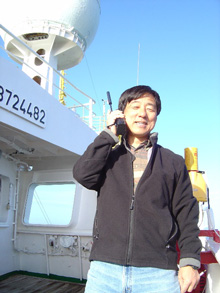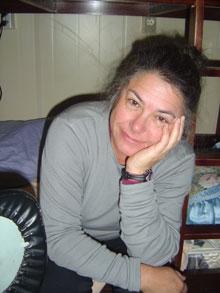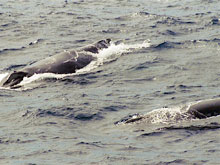Interview with Dr. Haru Matsumoto
Interview by William Hanshumaker
Bill: What did you learn from this mission?
Haru: This was our first experience with the deployment of hydrophones in the high southern latitudes area off Antarctica. Hydrophones are computerized microphones that record sounds created underwater by earthquakes, volcanoes, moving ice flows, and even the large whales. But floating icebergs, unusual sound paths, and the notoriously rough weather in the Drake Passage create conditions that complicate interpreting the sound patterns. Due to cracking ice, the ambient sound may be much noisier than at the mid-latitudes. Floating ice could deflect or absorb distant sounds. We are optimistic that we have prepared for these challenges but will not know for sure until next winter. In November 2006, we will go back to the Antarctic to recover the Autonomous Underwater Hydrophones (AUHs) and decipher their recorded sonograms. Only then will we know how well our hydrophones performed and if our assumptions are correct.
Bill: What advice would you give to students who are interested in ocean engineering?
Haru: The technology is advancing at such a fast pace that even concepts of how to design and build a system changes every five years. It is a challenge to stay current in this field. The good news is that the basics do not change even with technological advances. What helped the most in my career was a strong background in math and physics, which I received when I was an undergraduate student in Japan. When a new technology emerges, it is easier to adapt to the changes if you've mastered the basics in math and physics. The goal is to quickly apply the new technology to your field.
Bill: Where did you go to school?
Haru: My undergraduate degree is from Tokai University, Japan, and I earned a PhD in Ocean Engineering from the University of Hawaii.
Bill: Why did you decide to study ocean engineering?
Haru: I graduated high school in mid 1970s. Back then, the Apollo program had just ended, and public interest was shifting towards the oceans. Born and raised near the Pacific, I was always interested in underwater technology. The concepts of underwater habitat, ocean thermal energy conversion, and underwater communication fascinated me. I was also an electronically savvy kid. I built my own ham radios and Hi-Fi amplifiers with components that often came from junkyard. I consider myself lucky because ocean engineering was just the right match for me.
Bill: What part of your job you like the most?
Haru: I really appreciate being at an academic institution where I can enjoy the atmosphere of freedom. It allows me to generate my own ideas. I can even investigate unique ideas that may not demonstrate an immediate profit, but may benefit the environment in the long run. What satisfies me the most being part of a team that is very effective and consistently produces results.
Interview by William Hanshumaker
Bill: Why was a marine mammal specialist part of the expedition?
Sara: The hydrophones we deployed will record sounds from
1Hz to 110Hz. This
range includes the low-frequency vocalizations made by large whales- particularly
blue whales. We also get sounds from fin, sperm, Sei and Bryde's
whales, but our regular hydrophones only record the lower end of their full range.
Only one of the hydrophones we deployed is capable of recording higher frequencies
up to 440 Hz. This should help us get recordings of the upper ranges of whale
calls, and perhaps even sounds from marine mammal species we have not previously
recorded. When we analyze the hydrophone data next year, it will be very
important to learn what sounds might be from marine mammals that live or migrate
through the study area. While there is some information from reports from
other expeditions and ships, it was important to have a marine mammal specialist
participate in this expedition so that we would have an exact documentation of
the marine mammal species at the sites where we placed the hydrophones. When
we analyze the data, we will have a much better idea of what sounds might be
from what species we know for certain we saw while deploying the hydrophones.
Bill: What did you learn from this mission?
Sara: This was my first opportunity to observe marine mammals and birds in the Antarctic. It was fantastic to see species that I have only read about, but even more wonderful to see species in the Antarctic that I have observed in so many other places in the world: like humpback whales which I had just seen in the tropical Pacific not much earlier in the year, and here they were in the cold southern waters only a couple of months later. Our data from the hydrophones will add to our understanding of whale movements and migrations of species like humpbacks and blue whales that move over vast distances. It will also give us some insight to sounds that might correspond to specific behaviors. I observed lunge-feeding Minke whales right in the area where we deployed the high-frequency hydrophone. This is really great because, since our regular hydrophones can only record the lower end of their vocalizations, we'll finally have data which will let us describe more of their vocal range, both the extent of their sounds and what they might mean in terms of behavior. I also observed several pairs and trios of humpback whales and some other rorqual species in Drake Passage; throughout the couple of hours it took us to deploy the hydrophone we placed there. So, we are guaranteed to have recordings of at least three or four whale species, and probably different kinds of sounds that might correlate to large and small-scale behaviors.
Bill: What advice would you give to students who are interested in marine mammals?
Sara: This is a field that is evolving very quickly. It
is important to understand the environment where marine mammals live. I
strongly recommend focusing on oceanography or some other marine science
program. You
just can not understand the animals unless you understand the complex
world where they live. Technology is used in even the most basic
observational studies, so I would also recommend developing a strong background
in computer skills, math, and statistics, starting as early as high school
if possible. I did not become seriously involved with marine mammal
work until after I finished my undergraduate college degree in Art and
Biology. I felt very handicapped and it was tough to make up the
holes in my education during my Master's work. Exposure to and development
of some basic skills in the 'hard core basic sciences' early
on (no matter how much of a struggle it seems) will provide an essential
foundation.
Bill: Where did you go to school?
Sara: My undergraduate degree is in Art and Biology from
The Evergreen State College in Olympia Washington. I conducted all my graduate
work at Moss Landing Marine Laboratories in California, earning my Master's
degree in Marine Sciences from the University of California at San Jose
State. My Master's Thesis was on the social organization of
killer whales, looking at long-term relationships within and between pods,
and their matrilineal structure.
Bill: Why did you decide to study marine mammals, particularly cetaceans? How did you become an acoustician?
Sara: Seals, whales and dolphins have evolved unique
and amazing adaptations for living in what is essentially an environment
alien to the mammalian form. Whales and dolphins are especially fascinating
in that they spend no time whatsoever on land, where all the rest of the
mammalian orders live- even seals. I was always interested in animal
behavior and evolution, and I was always drawn to the ocean. I have
to admit that I grew up watching 'Flipper' which was probably
an early influence. But, when I was in high school there were very
few women in the marine sciences, so I did not even think about it
as a serious option. During my undergraduate years, two male friends
started working on a killer whale project in Puget Sound and I would visit
them fairly regularly. I went to one of the first Marine Mammal Society
meetings with them, where I met some of the few women who were successfully
pursuing careers in marine mammal science; it was then I realized that
this was a viable choice. My early work was looking at social organization
and behavioral ecology. How cetaceans use sound acoustics was a natural
progression from there. I have been with the Acoustics group of NOAA's
Pacific Marine Environmental Laboratory's VENTS program since 2001,
working principally on the acoustic characteristics of cetacean vocalizations
and secondarily on seismic activity.
Bill: What part of your job you like the most?
Sara: When I was younger, it was the fieldwork. Now
it is analyzing data because it reveals such interesting results. Being
at an academic institution lets me work on really innovative research that
benefits our understanding of the ocean environment in a way that I could
not have done by myself. I have to agree with Haru Matsumoto: much
of my satisfaction comes from being part of a team that is innovative,
effective and consistently produces results.
Sign up for the Ocean Explorer E-mail Update List.















